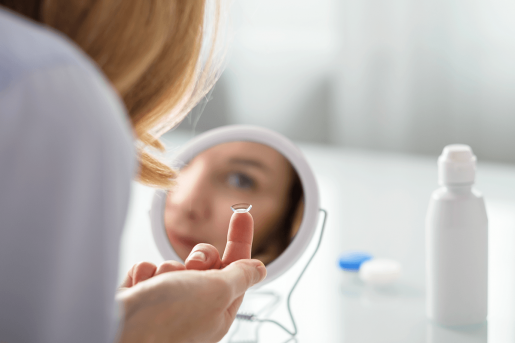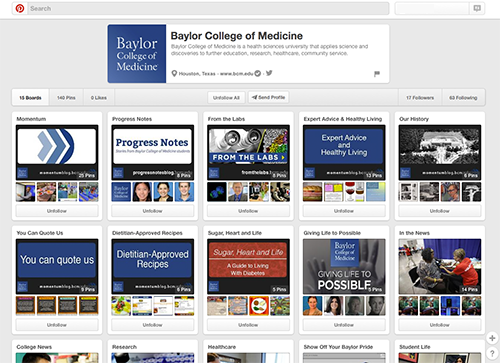Contact lenses 101

Clear, bright vision is unbeatable. Whether you wear glasses or contacts lenses, strong eyesight is crucial. A Baylor College of Medicine ophthalmologist provides tips for contact wearers, beginner or veteran.
“Contact lenses help correct the refractive error of the eye, so depending on if the eye is shorter or longer, the way light goes from the front to the back of the eye is bent differently,” said Dr. Masih Ahmed, assistant professor of ophthalmology at Baylor.
Those who are nearsighted have longer eyes, so light doesn’t make it all the way to the back of the eye. Glasses or contacts help to bend that light to make its way to the retina. For those who are farsighted, their eyes are shorter, and the light does not focus by the time it gets to the back of the eye; contacts or glasses help the eye focus.
Choosing contact lenses over glasses
Contacts sit right on the eye, whereas glasses sit off the eye. Contacts provide a 360-degree view and do not have the edge effect you get while wearing glasses. Contacts usually provide better quality vision.
According to Ahmed, contacts also serve a stronger purpose when treating astigmatism than glasses. Glasses can treat certain amounts of astigmatism, but because contact lenses sit on the eye, they work better for treating that, providing higher quality vision.
Types of contact lenses
Contacts come in soft lenses or hard lenses. Soft lenses are typically made of hydrogel or silicone materials and come in daily, weekly, biweekly or monthly packs.
Hard contacts come in different options. Rigid gas permeable contacts go on to the eye like a regular, soft contact, while scleral contact lenses are filled with fluid and vault over the front of the eye.
“Hard contacts are better for patients who have higher degrees of astigmatism or irregular shapes to their cornea. Hard contacts help overcome these visual limitations. Scleral lenses are great for patients with severe dry eye or other ocular surface disease because they’re full of fluid when you put them on the eye, so they keep the eye lubricated while you wear them,” Ahmed said.
The length of time in which you wear contacts depends on comfort. Some might wear them for 16 to 18 awake hours per day, while others might not tolerate them for that period due to discomfort or dryness.
What not to do
Most ophthalmologists do not believe in extended or overnight lenses. When you sleep, you do not blink, so the tears stay static on the front of the contact and bacteria can build up on the lens. If you get a small scratch in the eye, the bacteria that is already on that contact can get into the scratch and lead to eye infection.
“If you know you’re going to take a nap, even if it’s short, take them out and put them in some solution because those biofilms build up on the contacts over any period of time. Your eyes will thank you,” he said.
The material of contacts also attracts certain types of organisms that live in bodies of water, including pools and tap water. If you open your eyes under water, the contact will absorb anything in the water, which might include certain types of protozoa or amoeba that cause infections. If you have no choice, wear goggles that prevent water from entering the eyes.
If you play a sport, do lawn work or any activity where things could be flying around, wear protective eyewear over your contact lenses.
Common mistakes
Avoid rinsing contact lenses under tap water. Tap water contains organisms and bacteria that can lead to infection. If a contact lens pops out and you need to clean it, use contact solution.
Clean your contact lens case frequently or replace it with a new one as bacteria can build up over time. Certain solutions are stronger than others, so opt for a hydrogen peroxide solution that can clean the case well. Remember to leave your contacts in the case for at least six hours to allow them to neutralize before wearing them again.
Those who wear lenses that are designed for daily or weekly use should refrain from wearing contacts longer than the intended period. “The materials start to break down over time, they do not transmit oxygen as well and they collect bacteria, so try to change them out around the time they are due to be changed and do not wear them for longer periods,” Ahmed said.
If your eye hurts or feels discomfort, wear glasses that day as you might have a small scratch, and wearing contacts can worsen it. If the pain does not subside, call your optometrist.
Colored contact lenses
Colored contact lenses tend to carry higher risk because they are often not created by the same manufacturers as regular contact lenses. They might come from cosmetic companies or contain materials that do not transmit as much oxygen. If you want colored lenses, get them from your optometrist or ophthalmologist who can provide lenses from the same reputable dealer as regular contacts to avoid any risks.
“Beware of the ones you might get from a costume shop. They are more dangerous because you don’t know what the dyes are or how well they transmit oxygen. Always best to get ones that require a prescription,” he said.
Artificial tears
Eye drops specific for contacts are called contact lens rewetting drops. If you choose to use artificial tears, Ahmed recommends preservative-free drops as preservatives can get into the contact and might be toxic to the front of the eye.
“Contact lenses can be a great, freeing experience with proper hygiene and care. There is a learning curve to them, but usually optometrists do a really good job with teaching you how to use and wear them,” he said.
By Homa Warren




Dear University Administration,
I am writing to inquire about your institution and would appreciate your insights on the following important questions:
1. What are the key factors that make your university stand out among competitors in terms of academic excellence and student success?
2. How does your institution support international students in terms of cultural integration, academic support, and career opportunities?
3. What specific initiatives or programs does your university offer to ensure graduates are well-prepared for the evolving job market and technological advancements?
Thank you for your time and consideration. I look forward to your response.
Best regards,
Prospective Student